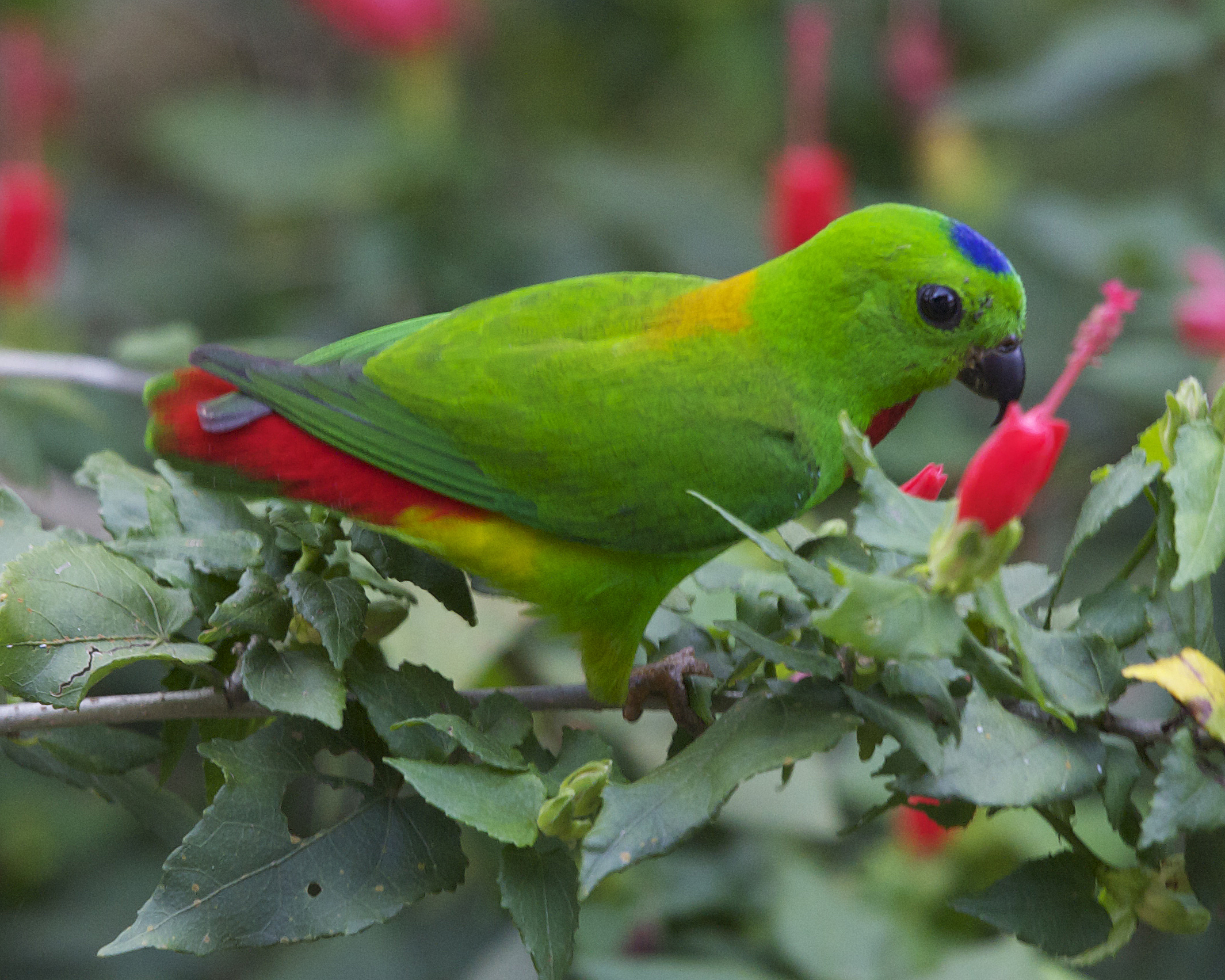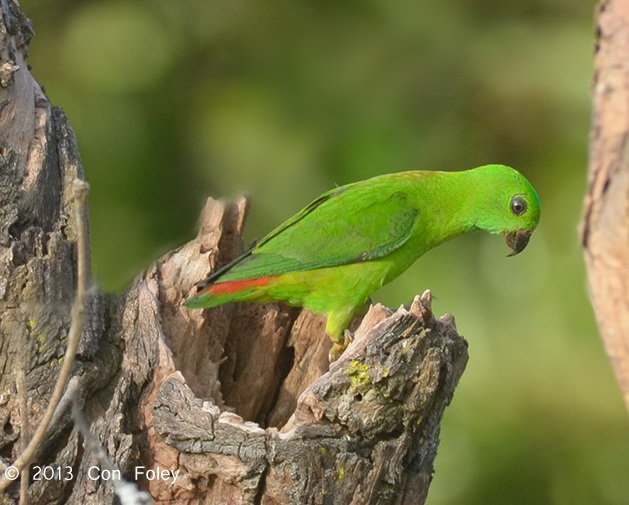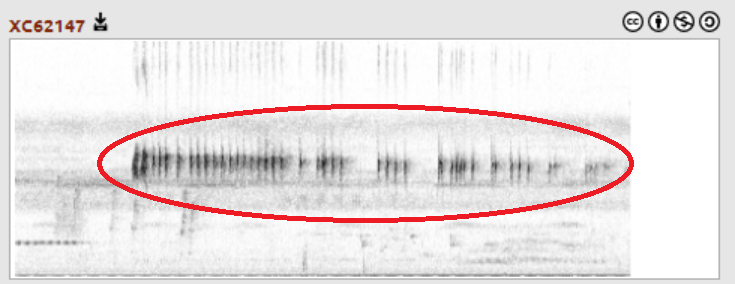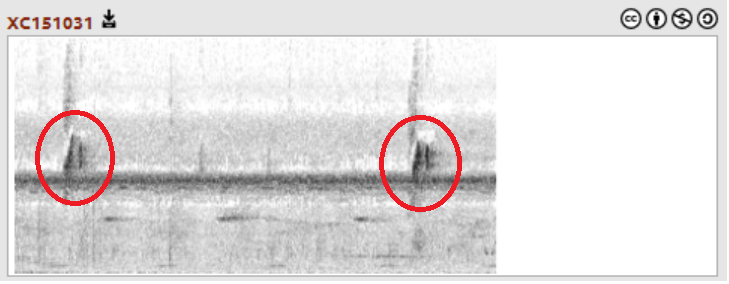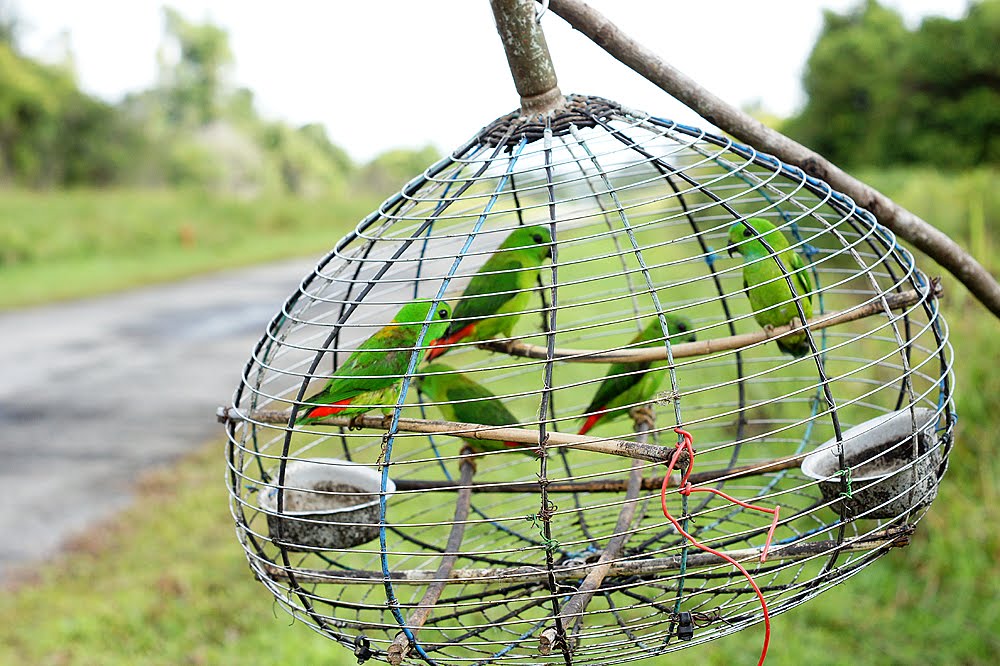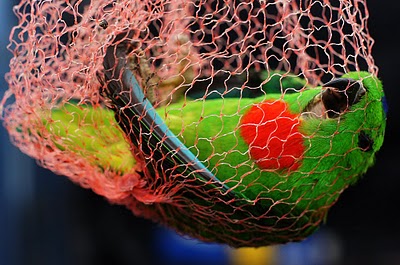Loriculus galgulus (Linnaeus, 1758)
Vernacular names: Blue-crowned hanging-parrot, Blue-topped hanging-parrot, Malaysian hanging-parrot, Malay lorikeet, Serindit (Malay), 蓝顶短尾鹦鹉 (Chinese)
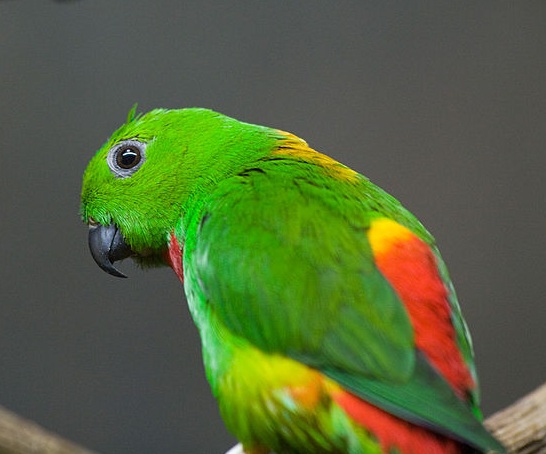 |
| © Frank Monnerjahn (Wikimedia Commons) |
Table of Contents
Distribution
This parrot can be found on the Thai-Malay Peninsula, Singapore, Sumatra and her surrounding islands, as well as Borneo and her surrounding islands. It has also been recorded in West Java, near Jakarta. [1] [2] On the Thai-Malay Peninsula, it is commonly found only up to about 7°N of the equator. North of this, it is only rarely recorded, perhaps only as a non-breeding dispersant. [3]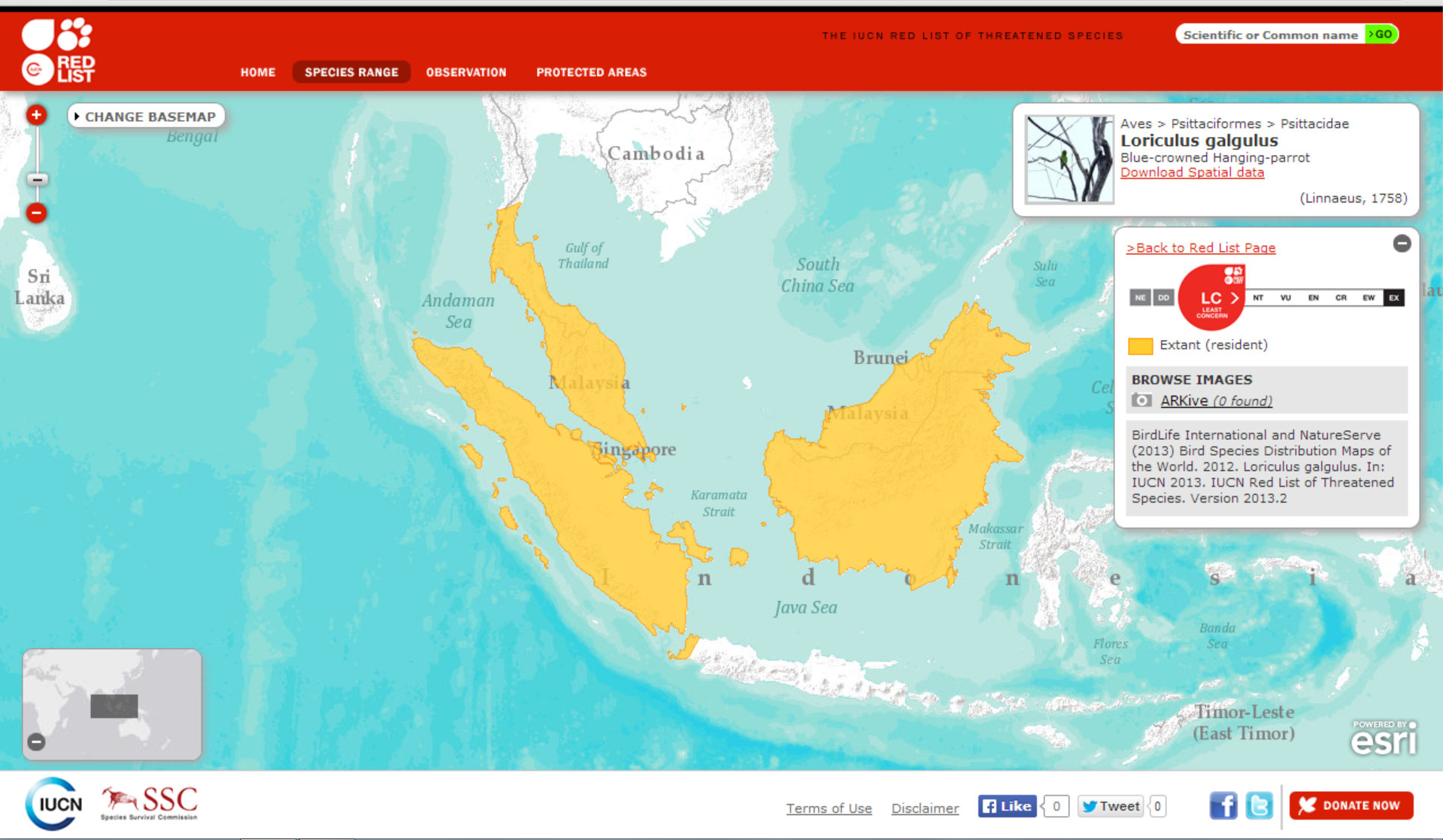 |
| Geographical distribution of the blue-crowned hanging-parrot. Map from IUCN. |
Description
Adult
The blue-crowned hanging-parrot is a short-tailed parrot that grows to just between 12 and 14cm, making it Singapore's smallest parrot[4] .Male: Mostly green with turquoise blue underwing and lower tail surface, a dark blue crown patch, golden-yellow "saddle" on its mantle (upper back), golden-yellow back band, red patch on throat/ upper chest, and red upper tail coverts. The eyes are dark and the bill is black.
Female: Like the male, but without the red throat and golden-yellow band on back. Also, minimal blue on crown and golden on mantle.[5] [6] [7] [8]
|
|
Juvenile
Juvenile birds look like adult females, but with wholly green mantle, and green rump with feathers margined with red. Their bills are coloured yellow or brown. [9]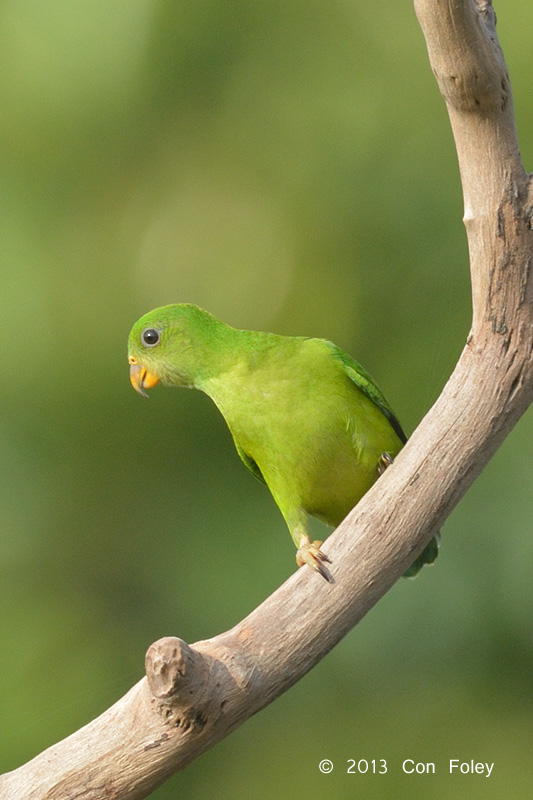 |
| Juvenile bird. © Con Foley. |
Diagnostic features in table form
| Feature |
Male |
Female |
Juvenile |
| Crown of head |
Blue crown patch |
Minimal blue on crown |
Minimal blue on crown |
| Throat/upper chest |
Red throat patch |
Green |
Green |
| Mantle (upper back) |
Golden-yellow patch |
Minimal yellow on mantle |
Green |
| Lower back |
Golden-yellow band |
Green |
Green |
| Upper tail coverts |
Red |
Red |
Green feather margined in red |
| Bill |
Black |
Black |
Brown/horn-coloured |
Diagnosis from similar species
The blue-crowned hanging-parrot shares part of its range with some other closely related hanging-parrots, which look superficially similar.In the northern part of the Thai-Malay Peninsula it is sympatric with the vernal hanging parrot Loriculus vernalis; males can easily be differentiated via the blue crown patch and red throat patch, which are present in the blue-crowned hanging-parrot but not in the vernal hanging-parrot. Additionally, the two species can be told apart by bill colour: black in the blue-crowned hanging-parrot, and orange-red in the vernal hanging-parrot. This can be used to differentiate between females of the two species. [10]
On the western end of the island of Java, the blue-crowned hanging-parrot is sympatric with the yellow-throated hanging-parrot Loriculus pusillus. Once again, the male blue-crowned hanging-parrot can be clearly diagnosed by the blue crown patch and red throat patch; as its name suggests, the yellow-throated hanging-parrot has a yellow throat patch. Females can easily be told apart by bill colour, which is orange in the yellow-throated hanging-parrot. [11] [12]
| Feature |
Vernal hanging-parrot |
Blue-crowned hanging-parrot |
Yellow-throated hanging-parrot |
| Crown patch |
Absent |
Blue (male), absent (female) |
Absent |
| Throat patch |
Absent |
Red throat patch (male), absent (female) |
Yellow throat patch (male), absent (female) |
| Bill colour |
Orange-red |
Black |
Orange |
 |
| Vernal hanging-parrot, blue-crowned hanging-parrot, and yellow-throated hanging-parrot males side-by-side, with the diagnostic features circled in red. Images adapted from Viwake (Wikimedia Commons), Robert from PBase, and Yongki Winardi. |
Ecology and Behaviour
| Male bird in the Singapore Botanic Gardens, feeding on palm fruit. © Con Foley. |
Habitat
The blue-crowned hanging-parrot is not particularly picky when it comes to habitat. It can be found in secondary and primary forests, forest edge, old plantations, mangroves, parkland, orchards, coconut groves, and urban areas, including trees in the heart of Orchard Road. [13] [14] [15] It has been reported to be more common in selectively logged forest than primary forest. [16] It generally ranges up to about 1300m above sea level, but has been recorded as high up as 2,000m above sea level at the summit of Tahan, Taman Negara. [17] In Singapore, it can be seen almost anywhere; the Botanic Gardens and other green spaces are particularly good spots for seeing these little parrots, especially if there are flowering or fruiting trees near by.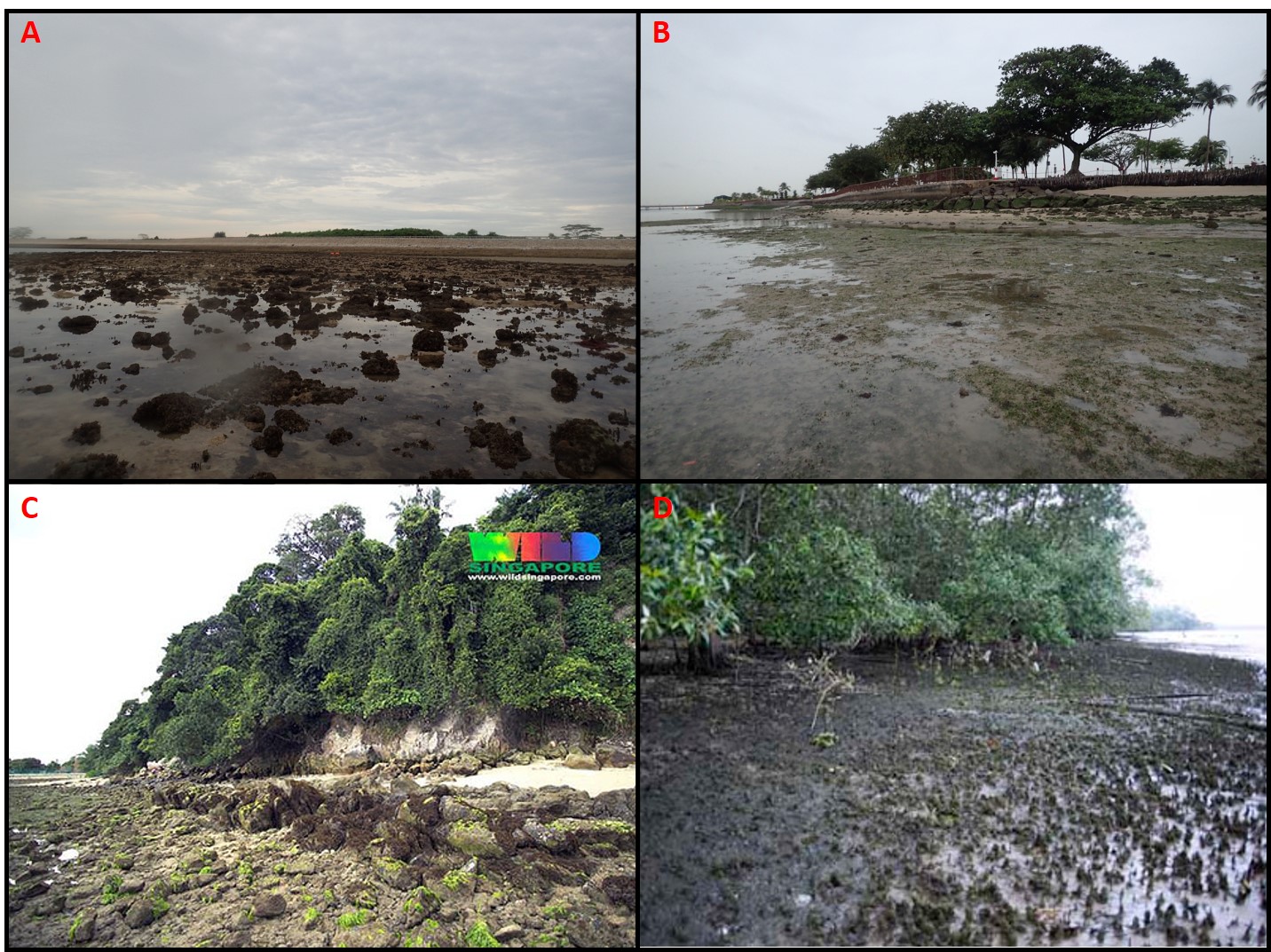 |
| All of these varied habitats are used by the blue-crowned hanging-parrot. First 4 images © Shengrong Ng, last image © Calvin Teo (Wikimedia Commons) |
Feeding habits
In the wild, this parrot eats nectar, flowers, fruits, buds, nuts and seeds. [18] It often feeds on fruit in orchards, and is frequently seen feeding on the mesocarp of oil palm fruits in plantations. In the wild, it has been observed feeding on the fruits of several fig species (eg. Ficus caulocarpa, F. virens, F. crassoramea, F. stupenda), and is also attracted to flowers (eg. coral flowers, Erythrina sp.). [19]Video of a male feeding on water apple (Syzygium sp.)
Video of a female feeding on flowers
Video of females feeding on mangoes
Lifespan
The maximum recorded longevity for this species in captivity is 14.3 years. [20]Behaviour and social interactions
The blue-crowned hanging-parrot ranges very widely, even moving between different islands. It may be truly nomadic, or it may trapline around a common range. [21] They move about mainly in the canopy and middle storey, and are usually observed singly or in pairs during the breeding season, or in groups numbering up to 150 birds during the non-breeding season. [22]These parrots employ a range of aggressive actions when spacing themselves at food sources. These include lunging at opponents' feet, gaping, as well as various wing movements such as displaying the inner wing colours by holding out the carpus of the folded wing, or stretching the entire wing out or up. Males courtship-feed females with regurgitated food; the most distinctive courtship display comprises of a run with the body held stiffly upright and red plumage-parts ruffled. [23] [24]
Like other parrots in the genus Loriculus, blue-crowned hanging parrots roost upside-down, hanging from both feet. In order to defecate in this position, the parrot transfers to one foot, flexes its body to 45°, and raises its tail. [25]
Reproduction
The blue-crowned hanging-parrot breeds in disturbed forests, in tree holes and cavities up to 12m above the ground in both live and dead trees. The breeding period runs from about January to August. Hanging parrots are one of the few parrot species known to build rather than merely excavate: they are purported to carry nesting material by tucking it into their plumage. [26] [27] [28] The clutch size usually numbers about three to four. The near-spherical eggs are white and glossless, and are incubated for 20 days. [29] [30] Chicks leave the nest about 33 days after hatching. [31]Voice
When in flight, this species often utters a shrill, high-pitched, metallic ringing call, usually approximated as tsi or tsrri, sometimes uttered repeatedly as tsi-tsi-tsi.... when the bird is in groups. When it is feeding, it often utters a shrill trrirt, and also bisyllabic call tir-rit or squeak-rit which may have an alarm function. Its Malay name serin-dit is oonomatopoeic in nature, and is an approximation of its call. Its threat actions are accompanied by a throaty, grating sound. [32] [33] [34]Video of a male calling:
Recording and sonogram of flight call, © Frank Lambert. Portion of sonogram correspond to the hanging-parrot's calls is marked out in red.
Recording of bisyllabic feeding call, © Mike Nelson. Portion of sonogram correspond to the hanging-parrot's calls is marked out in red.
Conservation
International Union for Conservation of Nature (IUCN) rating: Least ConcernConvention on International Trade in Endangered Species (CITES): Appendix II
The blue-crowned hanging-parrot is categorized as "Least Concern" by the IUCN, meaning populations are not in imminent danger of extinction in the near future. The world population thought to exceed 100,000, with populations thought to be stable. It is very common and widespread over much of its range. [35] In Singapore, this species used to be rare, but has made a dramatic comeback and is now a common parkland bird, probably due to the widespread planting of fruit trees across the island. [36] However, in Singapore it is still officially listed as "nationally endangered".
Threats
The species has been heavily traded: between 2012 and 1981, when it was listed on CITES Appendix II, more than 100,000 wild-caught individuals have been recorded in international trade.[37] Between 1985 to 1990, 38,381 birds were exported from Malaysia alone. [38] In parts of its range, wild populations are scarce in forests accessible to trappers due to it being commonly caught for the pet trade. [39] Trappers often take advantage of the birds' highly social habits to do this: captive birds are used to call wild birds down, which then get stuck in latex prepared by the trapper, [40] or trapped in specially prepared cages.The worldwide trade in birds captured from the wild, usually for the pet trade, is a large and cruel one. Between two to five million wild birds belonging to more than 2,600 species (comprising about a quarter of all known bird species) are traded yearly in the 1990s, with the Passerines (perching birds) and the Psittacines (parrots) particularly badly affected.[41] 26.8% of the world's parrot species (95 out of 354 species) are threatened with extinction[42] , largely due to the twin impacts of collection for the pet trade and habitat destruction. While the wild blue-crowned hanging-parrot populations do not seem to be too badly affected at the moment, they may not be able to withstand both these continuing impacts. Additionally, the process of capture, transport and sale is often fraught with pain, suffering and death for the birds: for every wild bird alive at a pet shop, many more birds have perished in transit. Many bird species in the region are suffering from unsustainable collection pressures: one example is the straw-headed bulbul Pycnonotus zeylanicus, which has been so extensively trapped for its song that it has been extirpated from most of its range and is in danger of outright extinction. [43] The wild bird trade is a cruel and unsustainable one, and we should not allow it to put any more species, including the blue-crowned hanging-parrot, in peril.
|
|
Video of a trapper retrieving a wild-caught blue-crowned hanging-parrot from a cage trap:
Etymology, taxonomy and phylogenetics
Etymology
The genus name Loriculus comes from the Latin word "lorica", meaning "armour" or "breastplate", with the suffix "-ulus", which means "little". The species name galgulus is a Latin word meaning "small bird". Loriculus galgulus thus can be roughly translated into "small bird with the little breastplate", probably referring to the red throat patch found in the males.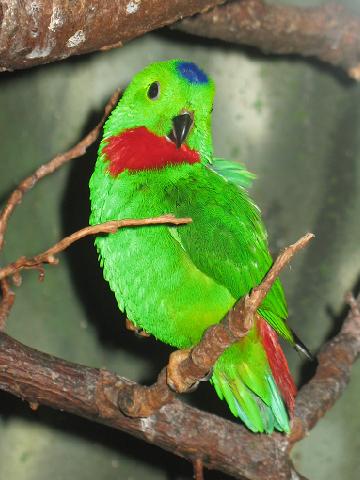 |
| Small bird with the little breastplate? Sounds about right. © Stavenn (Wikimedia Commons) |
Taxonomy
* Important note: As higher ranks in classification are arbitrary human constructs [44] [45] , I have elected not to list them, and instead list only taxon names.Animalia
Chordata
Aves
Psittaciformes
Psittacoidea
Psittaculidae
Agapornithinae
Loriculus Blyth, 1850
L. galgulus (Linnaeus 1758)
 |
| Original description by Linnaeus. The type locality is mistakenly listed as "India". |
Source: Göttinger Digitalisierungszentrum
The blue-crowned hanging-parrot was first described under the name Psittacus galgulus in the 10th edition of Linnaeus's book Systema Naturae, in 1758. The type locality was mistakenly listed as "India", instead of Malacca. Systema Naturae marks the starting point of binomial zoological nomenclature; before then, the majority of zoological catalogues used polynomial names when describing the taxa included in Systema Naturae.[46] The polynomial name on which Linnaeus based his description of the blue-crowned hanging parrot, for example, was Psittacus minimus viridis ruber indicus (quite a mouthful!), of Edwards 1743-51. [47] All the 34 parrots described by Linnaeus in Systema Naturae were lumped under the same genus name, Psittacus. [48] .
Beyond this point, the taxonomic history of the blue-crowned hanging parrot gets a little more confusing: while most taxonomic and biodiversity information sources state the species as having no synonyms [49] [50] , the World Bird Database [51] lists multiple subsequent descriptions of the species under a range of different synonyms. Examples include Psittacus pumilus Scopoli 1786 and Psittacula cyanopileata Bourjot Saint-Hilaire 1838. These subsequent descriptions notwithstanding, the name Psittacula galgulus remained valid due to the Principle of Priority in taxonomy all the way to 1850, which was when Blyth described the genus Loriculus and designated this species as the type species. The blue-crowned hanging-parrot was thus renamed Loriculus galgulus in 1850, which is its valid scientific name to date.
In 1912, Oberholser proposed splitting Loriculus galgulus into 2 separate subspecies Loriculus galgulus galgulus and Loriculus galgulus dolichopterus ; however, scientific consensus is that the species is monotypic with no distinct subspecies. [52] [53] [54]
Type Information
Unfortunately, photographs and information on the holotype of this species cannot be found online.
The type information of the two subspecies Loriculus galgulus galgulus and Loriculus galgulus dolichopterus is provided below.
However, do note that this distinction is generally thought to be invalid.
[55]
Name: Loriculus galgulus galgulus Oberholser 1912
Sex: Male
Location: National Museum of Natural History, Smithsonian Institution, Washington D.C.
Preparation: Skin (whole)
Collection location: Nias Island, Mojeia River, Sumatra
Collection date: 14 Mar 1905
Name: Loriculus galgulus dolichopterus Oberholser 1912
Sex: Female
Location: National Museum of Natural History, Smithsonian Institution, Washington D.C.
Preparation: Skin (whole)
Collection location: Enggano Island, Sumatra
Collection date: 06 Nov 1904
Phylogeny
The parrots (Psittaciformes) diverged from the perching birds (Passeriformes) about 74.8 million years ago. [56]Their placement within the avian tree of life is shown in the image below from Birdtree.org. A circular tree is being used here instead of a more conventional tree, as a circular tree is better able to accomodate the large number of branches required to illustrate the entire avian tree.
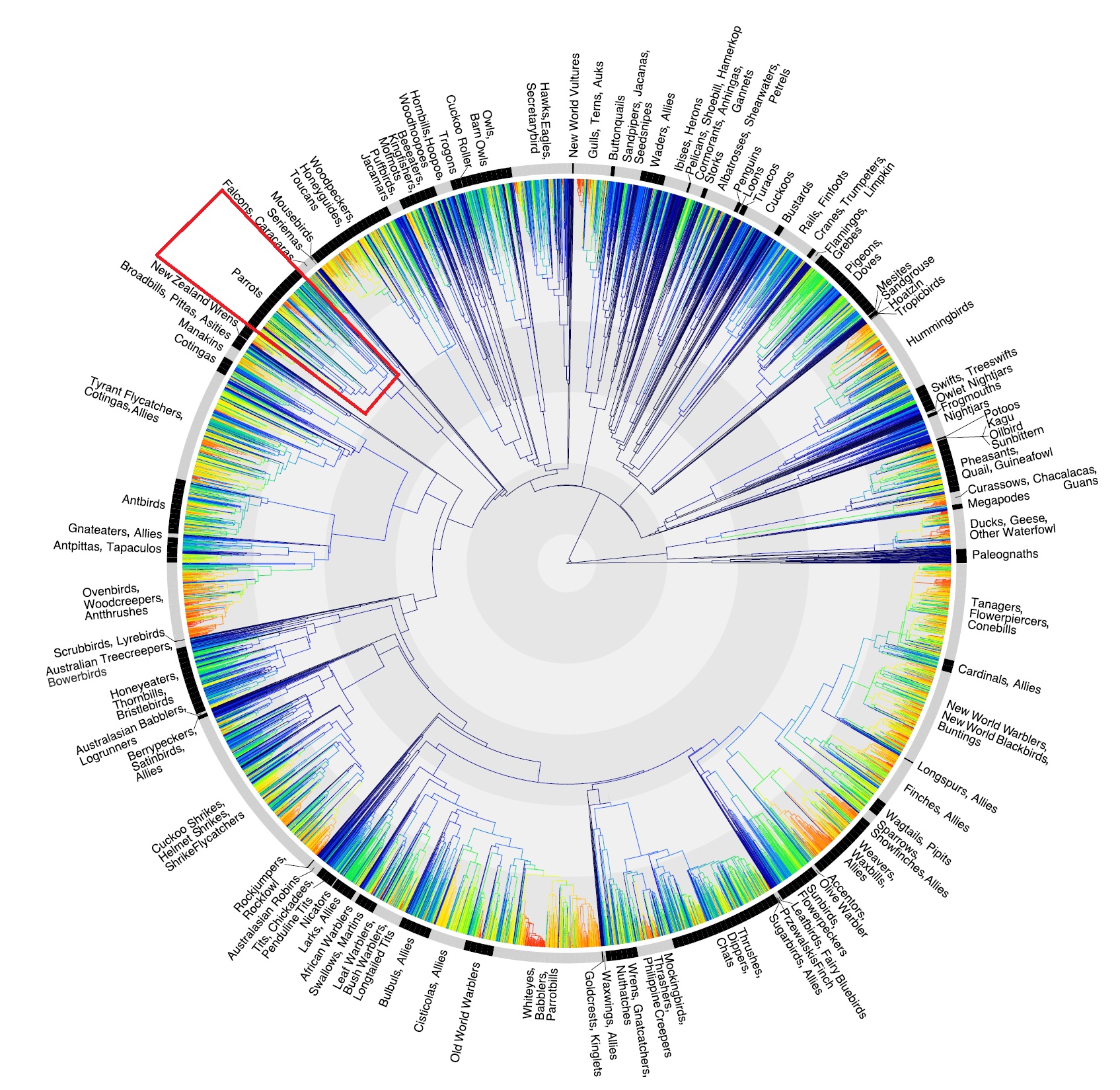 |
| Phylogenetic tree of the birds of the world, with the parrots marked out in red. source: Birdtree.org |
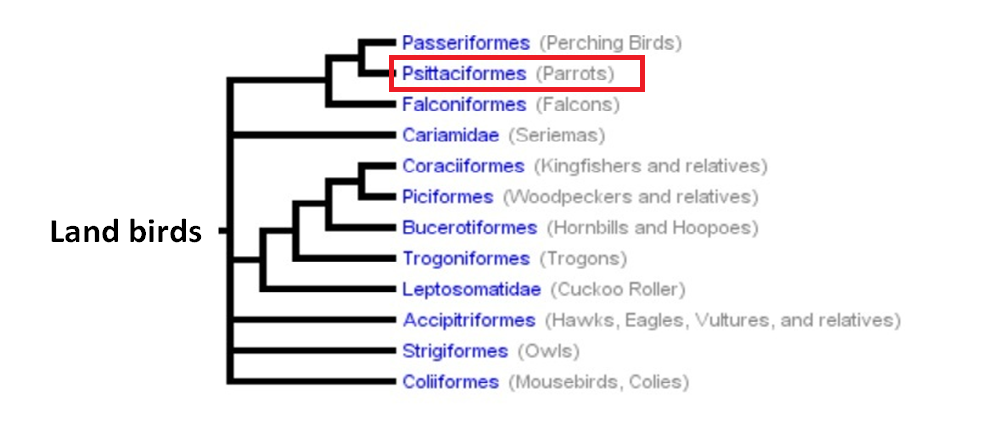 |
| source: The Tree of Life Web Project. |
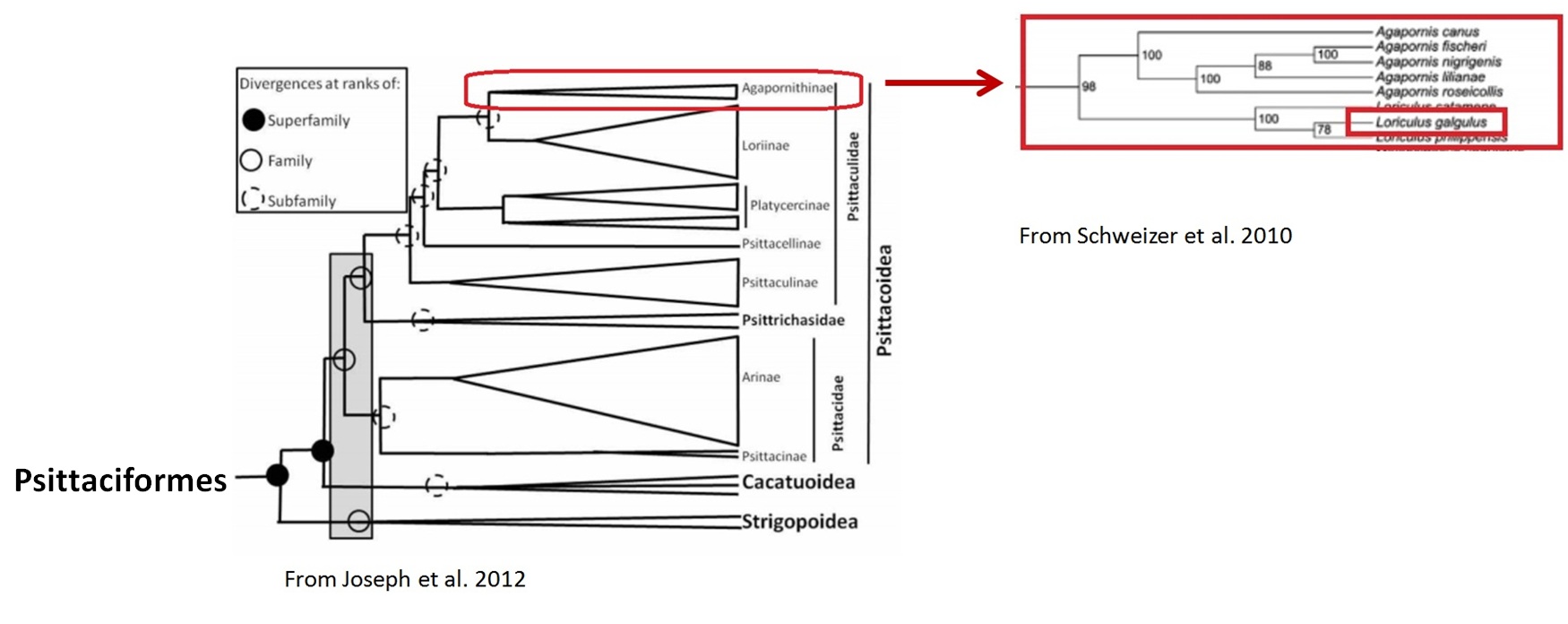
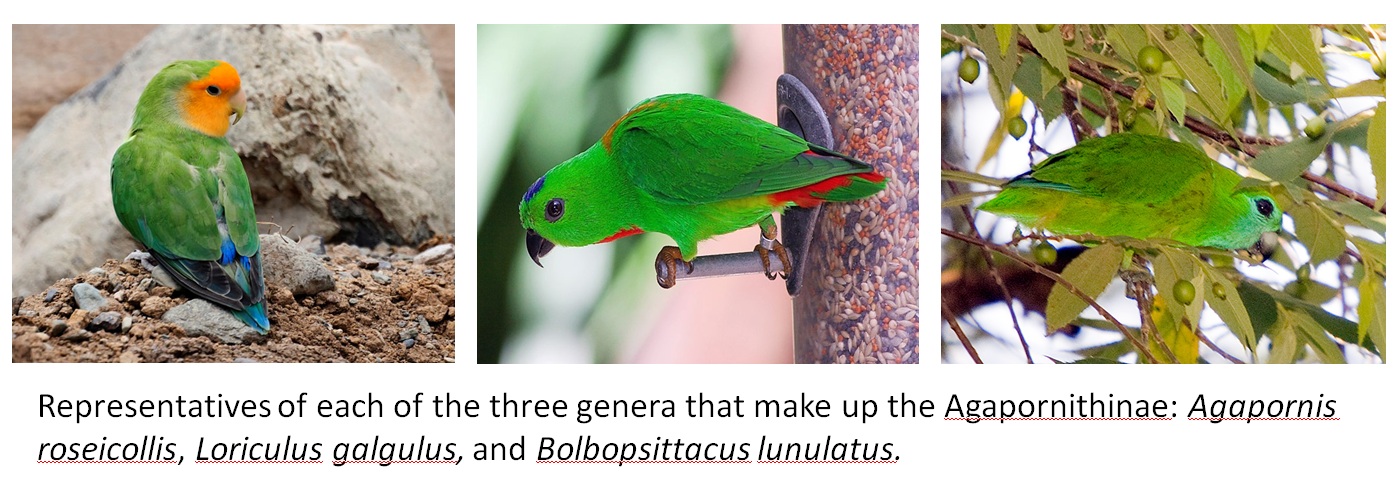
Loriculus image © Robert from PBase. Agapornis and Bolbopsittacus images © Juan Emilio and Luis Limchiu respectively (Wikimedia Commons).
Additional resources
Avibase: general information on the blue-crowned hanging-parrot.BirdLife International: BirdLife is the IUCN Red List authority for birds. This site contains information on and justification of the conservation status of birds all over the world, including the blue-crowned hanging-parrot.
Birdtree.org: this website accompanies the study on global bird diversity by Jetz et al. 2012 [62] , and contains a lot of information on the phylogenetic relationships and divergence times between bird clades.
Tree of Life Web Project: the Tree of Life Web Project provides a wealth of information about the characteristics and phylogeny of the world's biodiversity.
World Parrot Trust: general information on the blue-crowned hanging-parrot.
Encyclopedia of Life: general information on the blue-crowned hanging-parrot.
National Center for Biotechnology Information (NCBI): the blue-crowned hanging-parrot's GenBank records can be found here.
World Bird Info: taxonomic information of many of the world's bird species can be found here.
Xeno-canto Avian Sound Library: open-source sound library for bird calls.
Copyright information
All pictures from Wikimedia Commons are distributed under the Creative Commons Attribution-ShareAlike License.

All other pictures are used with the copyright holders' permission.
All recordings from Xeno-Canto are distributed under the Creative Commons Attribution-Non-commercial-ShareAlike License.

Literature and References
MacKinnon, J., & Phillip, K. 1993. A Field Guide to the Birds of Borneo, Sumatra, Java and Bali. Oxford University Press.
Yong, D.L., Lim, K.C., & Lim, T.K. (2013). A naturalist's guide to the birds of Singapore. United Kingdom: John Beaufoy publishing.
Robson, C., & Allen, R. (2005). New Holland field guide to the birds of South-East Asia. New Holland Publishers.
World Parrot Trust. (2013). Blue-crowned hanging parrot. Webpage. www.parrots.org. Accessed on 11th Nov 2013.
Wells, D. R. (2009). The birds of the Thai-Malay peninsula (Vol. 1). A&C Black.
Forshaw, J. M. (2010). Parrots of the World. Princeton University Press.
Robson, C., & Allen, R. (2005). New Holland field guide to the birds of South-East Asia. New Holland Publishers.
del Hoyo, J.; Elliott, A.; Sargatal, J. (1997). Handbook of the Birds of the World, vol. 4: Sandgrouse to Cuckoos. Lynx Edicions, Barcelona, Spain.
Brouwer et al. (2000). Longevity records for Psittaciformes in captivity. Int Zoo Yb, 37:299-316.
del Hoyo, J.; Elliott, A.; Sargatal, J. (1997). Handbook of the Birds of the World, vol. 4: Sandgrouse to Cuckoos. Lynx Edicions, Barcelona, Spain.
Buckley, F. G. (1968). Behaviour of the blue-crowned hanging-parrot Loriculus galgulus with comparative notes on the vernal hanging-parrot L. vernalis. Ibis, 110(2), 145-164.
Wells, D. R. (2009). The birds of the Thai-Malay peninsula (Vol. 1). A&C Black.
Buckley, F. G. (1968). Behaviour of the blue-crowned hanging-parrot Loriculus galgulus with comparative notes on the vernal hanging-parrot L. vernalis. Ibis, 110(2), 145-164.
Forshaw, J. M. (2010). Parrots of the World. Princeton University Press.
del Hoyo, J.; Elliott, A.; Sargatal, J. (1997). Handbook of the Birds of the World, vol. 4: Sandgrouse to Cuckoos. Lynx Edicions, Barcelona, Spain.
UNEP-WCMC CITES Trade Database. (2013). Website. http://www.unep-wcmc.org/cites-trade-database_495.html. Accessed 11th Nov 2013.
Food and Agriculture Organizations (FAO) and the Emergency Center of Transboundary Animal Disease (ECTAD), of the United Nations. (2008). International Trade in wild birds (and other relevant movements) in Latin America and the Caribbean. Report. Available online at: http://www.rlc.fao.org/es/prioridades/transfron/aviar/pdf/birtr.pdf
Jetz, W., Thomas, G. H., Joy, J. B., Hartmann, K., & Mooers, A. O. (2012). The global diversity of birds in space and time. Nature, 491(7424), 444-448.
Yong, D.L., Lim, K.C., & Lim, T.K. (2013). A naturalist's guide to the birds of Singapore. United Kingdom: John Beaufoy publishing.
Lee, M. S. Y. (2003). Species concepts and species reality: salvaging a Linnaean rank. Journal of evolutionary biology, 16(2), 179-188.
"Article 3". International Code of Zoological Nomenclature (4th ed.). 1999. ISBN 0-85301-006-4.
"Loriculus galgulus (Linnaeus 1758)." Encyclopedia of Life, available from http://eol.org/pages/1177936/overview. Accessed 26 Nov 2013.
"Loriculus galgulus (Linnaeus 1758)." Encyclopedia of Life, available from http://eol.org/pages/1177936/overview. Accessed 26 Nov 2013.
Smithsonian Institution. (2013). Website. www.si.edu. Accessed on 11 Nov 2013.
Jetz, W., Thomas, G. H., Joy, J. B., Hartmann, K., & Mooers, A. O. (2012). The global diversity of birds in space and time. Nature, 491(7424), 444-448.
Joseph, L., Toon, A., Schirtzinger, E. E., Wright, T. F., & Schodde, R. (2012). A revised nomenclature and classification for family-group taxa of parrots (Psittaciformes). Zootaxa, 3205, 26-40.
Wright, T. F., Schirtzinger, E. E., Matsumoto, T., Eberhard, J. R., Graves, G. R., Sanchez, J. J., ... & Fleischer, R. C. (2008). A multilocus molecular phylogeny of the parrots (Psittaciformes): support for a Gondwanan origin during the Cretaceous. Molecular Biology and Evolution, 25(10), 2141-2156.
Jetz, W., Thomas, G. H., Joy, J. B., Hartmann, K., & Mooers, A. O. (2012). The global diversity of birds in space and time. Nature, 491(7424), 444-448.
